11 Essential Tips for Driving in Mexico safely
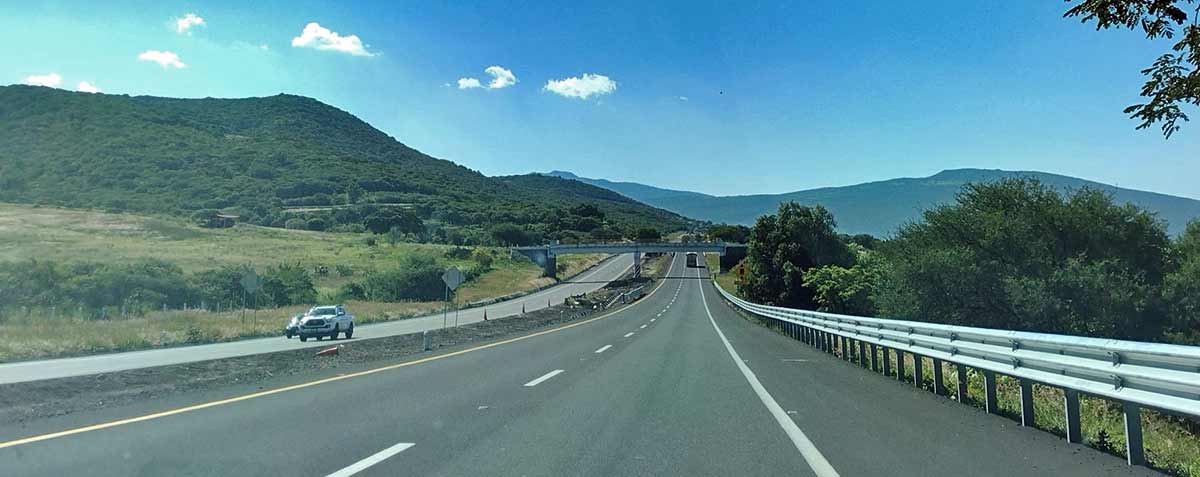
From stunning landscapes and bustling cities to delightful surprises off the beaten path, there’s so much to discover in Mexico. While there are good internal flights and several excellent bus companies, if you want true freedom to explore this wonderful country at your own pace, driving in Mexico is the only way!
The moment we tell anyone that we are planning a road trip, we get asked: “Is it safe to drive in Mexico?” or “Is is easy to drive in Mexico?”
These questions, and many like them, is nearly always prompted by the sensational (and invariably exaggerated) news reports about cartels, kidnappings, and violence.
It’s true that some parts of Mexico are best avoided for these reasons but, for the most part, driving risks in Mexico are less to do with violence and more because of the low standard of driving.
As you read the blog, don’t worry – it is detailed so being forewarned is forearmed. A blog about the differences in driving between the US and the UK could have as many warnings!
Read on to find out what you need to know before driving in Mexico.
Is it difficult to drive in Mexico? No! Using common sense and the information below, driving safely in Mexico is easy. And driving in Mexico is fun!
Table of Contents
THE BASICS OF SAFE DRIVING IN MEXICO
Here are the 5 most important tips for driving in Mexico. These driving tips are valid whether you are driving anywhere in the Yucatan Peninsula, from Cancun to Tulum in Quintano Roo. Or you want to enjoy a grand road trip driving through Mexico from the Caribbean to the Pacific Ocean to get to Puerto Vallarta.
Find out how the driving laws in Mexico can be different to home, how to avoid problems and things to look out for when you’re driving in Mexico.
In other words – what to expect when driving in Mexico!
1. The biggest dangers of driving in Mexico are mainly the drivers
The dangers of driving in Mexico are primarily the other drivers! This may seem a bit harsh. There are some excellent drivers, courteous, and patient. And some who are not. Sadly, the latter are the majority.
The basic problem is the training or testing – or the lack thereof. From conversations with friends, driving tests are often a formality rather than a serious assessment of skill. (The same is true of Malaysia, where the lessons are hopelessly inadequate and passing the test involves little more than turning up).
Add to that a wide variation in styles of driving across a huge country and you have a recipe for ‘interesting’ driving. To be fair, driving far out in rural areas with few cars about is a far cry from navigating the Merida Periferico (Ring Road) at rush hour. (Merida inhabitants may be surprised to learn that the Periferico was classed as the 5th most dangerous road in Mexico!)
It is noticeable that in many situations, the police are more relaxed than the UK or the US when it comes to enforcing minor infractions. For example, the young lad who rammed into the back of my car on the Merida Periferico early this year was uninsured. The police were unconcerned so long as the liability was sorted out. This approach seems to be fairly common.
This pragmatic approach, plus the occasional corrupt officer, doesn’t engender respect for law and traffic rules.
Road etiquette
Road etiquette also plays a role in determining Mexican driving quality. Honking horns, flashing headlights, and aggressive maneuvers are not uncommon sights on busy streets. Patience and defensive driving skills are essential when navigating these situations.
2. Road Rules – adherence to them and their random application
It’s not just the styles of driving that varies by location. The laws of the road also differ by state. What is allowed in one state, for example turning right on a red light, is forbidden in another.
You’ll often see road rules simply ignored. In a few places, a one-way street is viewed as a suggestion rather than a law.
For the most part, the major road signs are the same as you would find in your home country. But not always.
But road signs can be confusing (or simply missing). It’s not uncommon the see two different speed limits posted for the same stretch of road. Street signs and stop lights are often obscured by shrubbery or trees.
In Merida, the secondary road at a crossroad is typically marked by ‘Alto’ signs, signifying the other road has priority. These signs are not always obvious. One friend was sideswiped by a car completely unaware they didn’t have right of way.
In Playa del Carmen, several of the crossroads don’t have any signs, so it’s down to the most forceful or fastest driver to claim the right of way!
Elsewhere, a crossroads system with signs saying ‘Uno y Uno’ is in force. This means that cars on each road take turns crossing. This seems to work well.
Regardless of what you see others do, for your own safety:
- Always wear a seat belt.
- Never drink and drive.
- Be aware of what’s going on around you.
- Don’t lose your focus on the road (fiddling with your phone, etc.)
- Obey speed limits, use turn signals properly, and respect traffic signs – ignoring these are among the favorite reasons why the police will stop you.
3. The roads can be great – or offer an interesting experience!
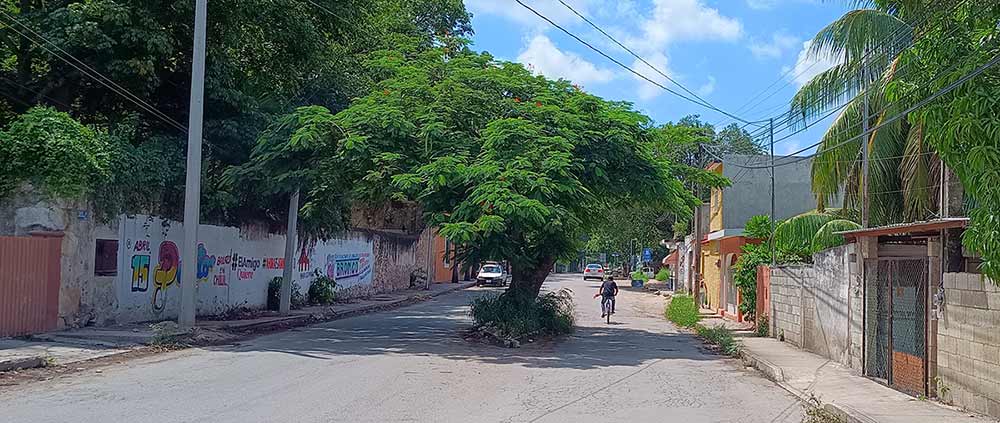
As can be seen in the header photo, odd things can be found in the road – like this tree! For this reason, it’s important not to lose concentration at any point during your drive. Trees, dogs, cows, bicycles, pedestrians, and more, can appear on the road in the most unlikely places.
The road surfaces vary from world-class to third-world appalling. For the most part, the roads in the Yucatan are of good quality. We were delighted at the superior quality of the highway roads in Michoacan.
Potholes – the hidden curse of driving in Mexico
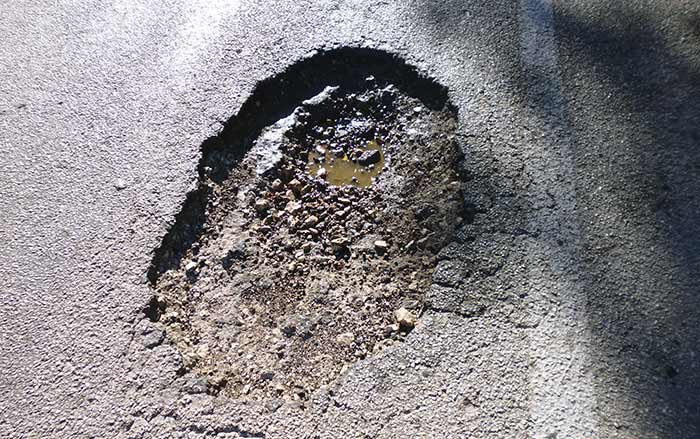
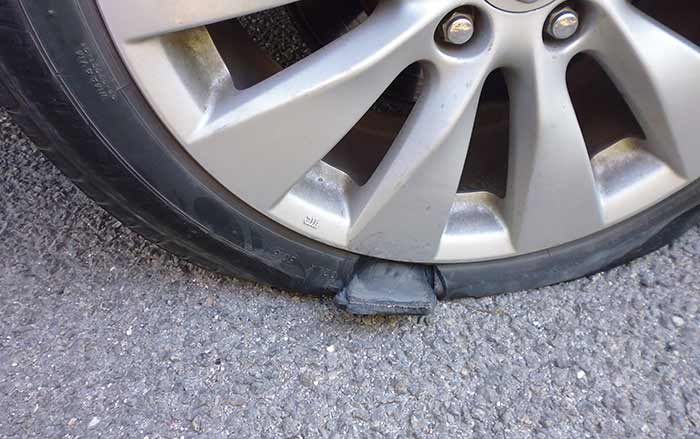
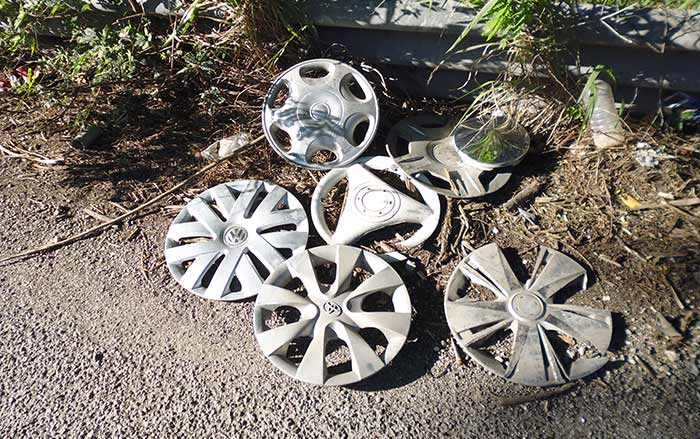
On the other hand, the main road between Puerto Rico and San Antonio Cardenas on the 180 from Cuidad del Carmen to Frontera in Tabasco is possibly one of the worst supposed highway roads I’ve seen anywhere in the world.
There are potholes along its length. One was so deep it ripped my tire in half. On the return side of the road, the road has melted and, under the weight of the constant lorries, has created rolling waves of tarmac, making driving a nightmare.
To be fair, potholes can happen anywhere. In East Sussex, UK, the large number of potholes appearing during the winter of 2022 led to humorous (and unofficial) roadside signs warning car passengers to ensure their dentures were firmly fixed before tackling the roads.
Potholes are normally repaired quickly by the appropriate road authorities. In some parts of Mexico, that does not seem to be the case, leading to potentially dangerous road conditions.
Topes are designed to make you slow down – they really work!
Another annoying road obstruction are topes (pronounced toe-pays). These are speed bumps intended to make you slow down. They vary in size and style from a simple length of thick rope laid across a road to 9” high (or higher) concrete strips across the road.
There are many variations used across Mexico. Larger, wider topes are also used as pedestrian crossings.
The one thing topes or speed bumps have in common is that you do need to slow down or risk damaging your car.
In bigger towns and cities, most topes are painted yellow or have a warning sign. Sadly, neither the paint nor the signposts are guaranteed.
In poor light – or bright sunlight – an unpainted speed bump can be all but invisible. Hitting an unmarked 4” high ridge of concrete at even 40 mph (60 kph) is not advisable. (You could lose more than your dentures!)
If you drive on the free roads, you’ll find every small hamlet or village has numerous topes as you enter and leave. They are effective in reducing speed and saving pedestrian lives.
When it rains in Mexico, it really rains.
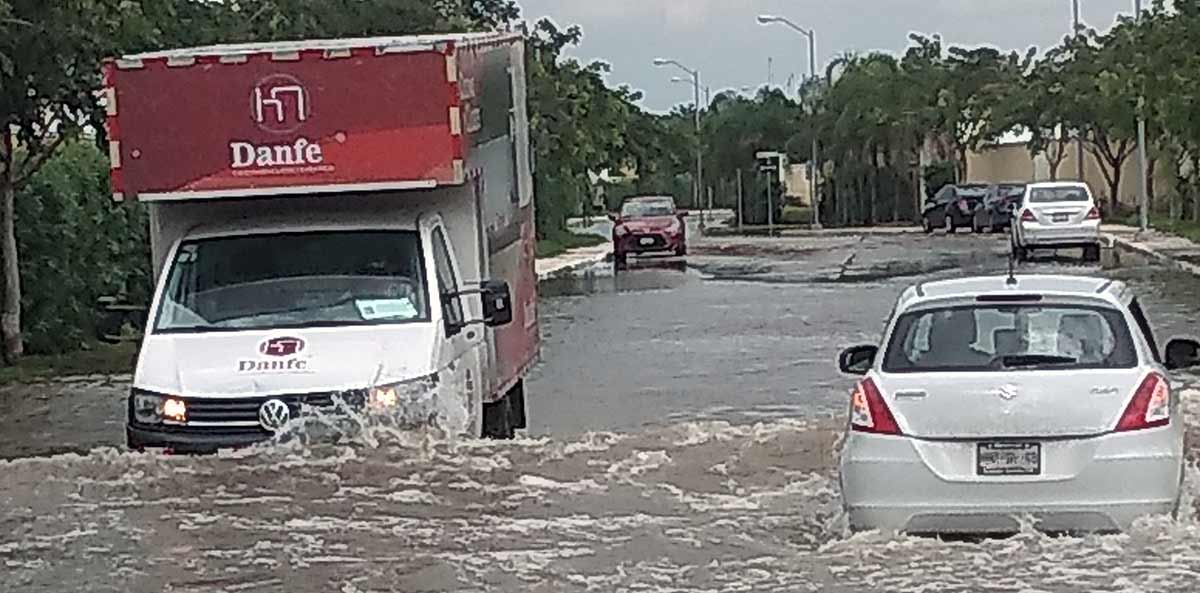
In most regions in Mexico, there is a rainy season which is when the hard rains become torrential! Unfortunately, either due to the terrain or lack of maintenance, proper water runoff is negligible and the rain quickly collects on the roads.
Within a very few minutes, the water is inches deep and the roads are flooded. Roundabouts (Glorietas) can quickly become a nightmare, as one part may be heavily flooded and you find three lanes of traffic trying to cram into the one dry lane to avoid the deep waters.
When driving in the rain be extra cautious. The ever-present potholes can be lurking under the surface. It is also hard to gauge how deep the water is. I often pull over and watch a few cars go through the deep water so I can judge the safest route.
Many drivers seem unaware of the danger of wet roads and will still race along. They run the risk of aquaplaning and may find out the hard way their brakes don’t work so well in the wet as they do in the dry.
4. Always keep your fuel tank topped up
It may be an obvious thing to say, but always keep your tank well above half full. Many stretches of road run for many miles without a single gas station. That can be hundreds of miles!
You may find yourself stuck for an hour or three in a traffic jam or climbing up a series of steep hills or mountains. In both cases, your fuel consumption will change radically.
By keeping your tank topped up, you can choose which gas station you want to stop at, rather than be forced to stop at some sketchy station in an area you would prefer to drive past!
5. Driving in Mexico at night is dangerous - True or False?
Do not drive at night in Mexico! Driving at night in Mexico is dangerous!
Why is there a recommendation not to drive at night in Mexico? This is the normal advice and, in many cases, it’s sensible. But probably not for the reason you think.
The danger has less to do with violence and more to do with the state of the roads and the absence of light!
I’ve mentioned the many potholes and topes to be found in Mexican roads. They are hard enough to see during daylight, but at night they are all virtually invisible. Unless you are driving very slowly, you may miss one. Changing a tire due to a pothole at night on the side of the road is not something you want to do! In any country.
Bicycles without lights, dogs, or livestock, are among the many other hazards that lurk unseen in the gloom.
The streets in many towns are not lit. And the street lights that do exist rarely add any illumination to the road.
Due to the lack of vehicle inspection, a lot of cars have headlights that are badly adjusted. It can be hard driving at night when every other vehicle coming toward you has its headlights on full beam!
Cities and larger towns are normally different. The roads are better lit and, hopefully, the roads are better quality with fewer cows! I have no qualms about driving in Merida, Cancun, Puebla, or other cities at night. In some cases, it’s better because the traffic is less than you’d find during the day.
ADDITIONAL TIPS ABOUT DRIVING IN MEXICO
Here are 5 more tips on how to drive in Mexico safely and enjoyably. These tips will explain the best routes to take, scams to avoid and what to do in case of emergency or an accident. And have you wondered what to do when stopped by the police? Read on:
6. Toll Roads versus Free roads
There is a good network of roads running across Mexico. These fall into two main types – Cuota /Toll roads and Libres/Free roads. They are normally well-signposted so you have the choice of how to proceed to your destination.
Depending on the time you have available, the time of day, and your preference the free roads can make a pleasant detour.
For instance, when we drive to Cancun from Merida we are typically in a rush, so we use the toll road. On the way back, we’re more relaxed and take the free road. This allows us to stop at the many market stalls, plant nurseries, etc., along the way and enjoy the actual journey rather than the drive. It probably adds about one hour extra to the drive but it’s worth it.
However, I know these roads well and they’re safe, even if we linger into the night. This isn’t always the case, so check your route before wandering off the toll roads.
The costs of the toll roads can be surprisingly high. On our trip from Merida to Puerto Vallarta this year, we found one toll that cost a mere MXN11, while others were over MXN400!
Just because you’ve paid to use a toll road doesn’t mean either the quality of the road is good or that there won’t be traffic jams. Also, you may pay a toll and soon find you are on a free road going through small towns, only to be back on a highway again a few miles further on.
The beauty of toll roads is that they are policed more, so are safer from non-traffic problems. There are no topes but there may be potholes. But you should be spared pedestrians and livestock wandering across the road.
Driving in Mexico – Paying for Tolls
Note that no tolls will accept cards or foreign currency. You can only pay with (Mexican) cash or with one of the several electronic toll collection devices now available in Mexico.
I use a Tag Televia device to pay for the tolls on long journeys.
You can buy the Tag Televia at most OXXOs, where it costs MXN150. Top-ups can be done either online or at an OXXO, which are frequent along highways at Pemex stations (and almost everywhere in most towns and cities).
The advantage of this device is it saves carrying large amounts of cash. The cost of tolls from Merida to Puerto Vallarta was just over MXN3,900 (one way). I did not want to carry an extra MXN4,000 in cash just for tolls.
Another benefit is it’s normally quicker getting through the tolls. Some toll booths have special lanes just for the automatic passes, which is a boon if there’s a lot of traffic. Tag Televia is accepted at most (not all) toll booths.
This link is to the Government toll calculator. It will help you plan your trip, show you where the tolls are, and the costs. It also shows what type of electronic toll collection device is accepted at each toll.
Angels to the rescue – coping with problems on the highways
A good reason to ensure you have a local Sim card and a fully charged phone is to call for help if you have a problem.
The Green Angels (Angeles Verdes) is a Mexican tourist agency-sponsored organization that was formed in the 1960s to provide help to Mexicans and tourists in case of vehicular or medical problems.
The teams are meant to be bilingual and operate 24 hours a day. You can call them on 078 or phone them at 01-800-987-8224
If you can’t get a signal, just pull over to somewhere safe and lift your hood. One of the Green Angels teams will arrive in their distinctive green and white truck. (How quickly depends on where you are).
The service provided by the Green Angels Mexico is free (unless they need to provide materials) but they always appreciate (and deserve) a tip to show your appreciation.
7. Police doing a great job under pressure - mostly
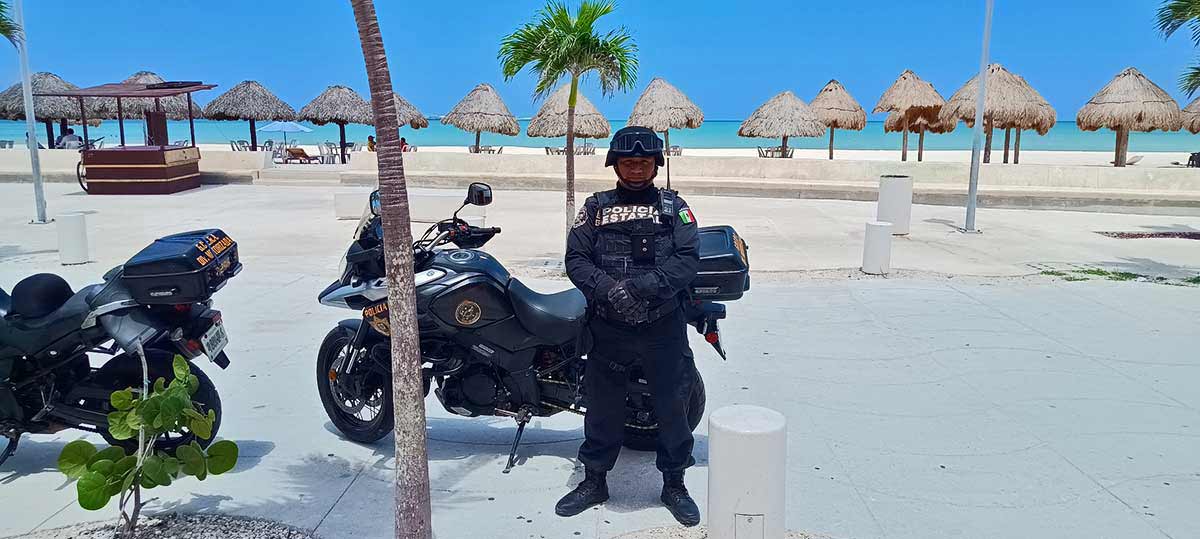
The police in Mexico do a job that is more difficult and dangerous than their counterparts in many parts of the world. Like everything in Mexico, the quality of the police varies across the country.
Inevitably, if you drive for many miles in Mexico, you will come across a police checkpoint. Sometimes, these are replaced by military checkpoints but the approach is the same. The police are looking for troublemakers and, if you’re a tourist acting sensibly, they will rarely be interested in you. I’ve never been stopped at such a roadblock.
I have been stopped several times at breathalyzer stops, which become very frequent around holiday periods. It would be very unwise to drink anything and drive at these times unless you are very confident you know your limit (which varies by state).
In the Yucatan, I have always found the police friendly and helpful. When my car was rear-ended on the Merida Periferico, the police were on site within minutes. A few of them stopped all the traffic on the highway so the two damaged cars could drive to safety on the far side of the road. (The fact that 8 other accidents occurred in the same spot within the following hour suggests that this was a well-known blackspot!)
On another occasion, I drove the wrong way down a one-way street. Initially, the policeman who stopped me started writing out a ticket but after some discussion (and with no hint or request for a bribe) told me to be more careful and let me go.
It’s not uncommon to see police cars parked near a broken-down vehicle, with the officers helping with a tire change.
What to do if you’re asked for a Bribe
Police corruption is more prevalent in some parts of Mexico than others. However, this is also true of many countries I’ve driven in, such as South Africa, Indonesia, and Malaysia.
My friends, both Mexican and ex-pat, who have been asked for bribes have always had a polite chat with the officer involved, refused to pay, and been told to move on. If you keep the conversation friendly and light-hearted, you will probably have no problem.
Bribes are normally asked for spurious violations, such as a fictitious speeding fine or not using your indicators. The policeman is trying to spook you and knows it. Friendly banter will normally work. Playing dumb – ‘no hablo Espanol’ – can also work.
I have a dashcam on the windscreen that is hard to miss. Friends have told me this tends to discourage unwarranted attention.
Being stopped late at night on a highway for a valid traffic violation is a different story. You need to use common sense and politeness, after all, you have broken the law and know it. Taking a superior or stroppy attitude will not help. If you are faced with spending a night in a local jail or greasing a palm, you need to assess the odds and favor your safety.
At the end of the day, discouraging bribery is the wisest course. And the best for future road users in Mexico. But what you do is down to your conscience and the situation you find yourself in.
8. What if I have a car accident when driving in Mexico?
This was one of my biggest worries when I first started driving in Mexico. I was fed lurid stories of being in a fender-bender and being whisked off to a local jail to spend the night making friends with local hoodlums. (So much for my friends’ sense of humor!)
In essence, however, the basis of the story is correct. If you have an accident, the police will arrive quickly. You must wait on the scene until your insurance assessor and that of the other driver have agreed on liability including payments for the damage.
If no agreement can be reached, the free board and lodging at a local jail could then become a reality. I’ve never heard of it happening, though.
The reality is this is a well-known process. It’s normally handled slickly by the police and the insurance brokers. I can’t say ‘quickly’ as there is often a long wait for the assessor to arrive followed by tedious discussions about who’s at fault.
The police tend to be pragmatic about the situations as they have other things to do. So, if it’s quicker to pay an uninsured and uninjured motorbike rider MXN500 for a new helmet in order to avoid paperwork, so much the better.
Important steps if you are involved in a traffic accident
These are the steps you need to take after an accident, once you have ensured no one is injured and the vehicles are not causing an obstruction:
- Make sure the police are on their way. Phone them or make sure someone else has.
- Phone your insurance agent next. Listen to their advice and follow it to the letter.
- Take lots of photos of both vehicles.
- Get the details of the driver as soon as possible.
- If there witnesses, get their details. They are likely to vanish quickly!
- Don’t admit anything.
- Above all – wait for the police. Do not leave the area until they say so. It doesn’t matter if you have a flight to catch, wait until the police permit you to leave.
Always make sure you have the correct, sufficient insurance for the vehicle you’re driving, whether it’s yours, borrowed, or a rental.
9. Gas Station Scams
Like most countries, Mexico has its fair share of scam artists. These can spot a tourist driving a mile off. If you know the games they like to play, you can avoid problems.
The most common scam at gas stations is to give incorrect change. Once the tank has been filled and you hand over several notes to pay, the attendant will slyly switch your largest note for a smaller denomination. They then demand more money. Be warned these crooks are quick and very good at this!
The attendants rely on tourists being distracted, unfamiliar with the Mexican notes, or unwilling to cause a fuss. (Be careful with your Mexican notes – there are now several denominations that share the same color. A $500 note can either be brown or the same blue as the $20 note!)
Despite knowing of this scam, I got caught at a gas station in Puerto Moreles. I immediately knew what had happened and demanded to speak to the manager. It was obvious he was aware of the scam at his station as he quickly gave me the correct change.
Don’t get distracted. Double-check what notes you’re giving before you hand them over. Stand your ground if you know you’ve been cheated.
Two less common scams when driving in Mexico
Paying by credit card can also be an invitation to problems in some places. The scam is simple: your card is run through the reader and you put in your PIN. The attendant then says it didn’t work due to poor signal. You pay cash, only to get home to find the card reader did work and you’ve paid twice!
Another scam I’ve been told of but not seen, is not resetting the pump before filling your tank. You end up paying again for the previous person’s gas. However, the attendant at every pump I’ve used over the past few years has always asked me to check the pump is at zero before they start to pump.
Beware of overly helpful attendants!
At most gas stations, the staff are genuinely friendly and helpful. Many will wash your windscreen or offer to check your tire pressure.
A scam I was warned of by a Mexican friend involves ‘overly’ helpful attendants. They will alert you to a minor issue with your car – perhaps a puddle of oil under the engine (that was already there). You are then convinced to pay for expensive engine oil (or whatever is needed) but this is switched out for an inferior brand without your knowledge.
10. Lorries and other vehicles to avoid - if you can
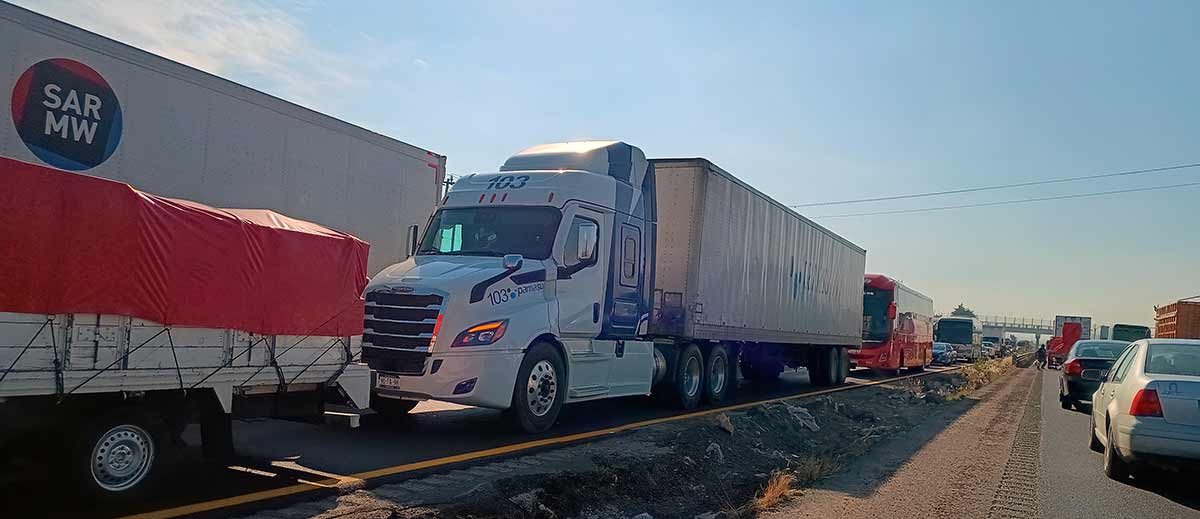
Lorries, also known as trucks or big rigs, are a common sight on Mexican roads. And, unfortunately, it’s impossible to avoid them!
These large vehicles play a crucial role in transporting goods across the country. However, they can also present some challenges for drivers.
One thing to keep in mind when sharing the road with lorries is their size and weight. These vehicles are much larger and heavier than regular cars, which means they require more space to maneuver, along with longer distances to come to a complete stop.
Another factor to consider is that lorries often travel at slower speeds than other vehicles due to their size and the cargo they carry. This can be frustrating if you’re confronted with a long line of lorries on a single-lane road due to traffic works.
Be mindful of lorry drivers who may need extra room when making turns or changing lanes. Give them plenty of space and avoid cutting them off abruptly.
Buses, on the other hand, rarely stay in their lane. They are also big but always seem to be in a rush. It is simply not worth trying to block them, even if it is your right of way. If you want a reason to give way to buses – look at their fenders, front or back. The extent of the damage should be enough to convince you who would win in a chicken contest! Not you.
Other vehicles to watch out for are the Collectivos or local minibuses. These are more prevalent in towns, buzzing along the roads, and weaving in and out of traffic. They tend to stop abruptly and without warning to drop off or pick up passengers.
BE PREPARED WHEN DRIVING IN MEXICO!
Is driving in Mexico safe? As we’ve seen, in general the answer is yes. But being prepared for any car trip is important. Here are two final tips for driving in Mexico safely and knowing you’re ready:
11. Getting ready to drive in Mexico
Documentation
Before you embark on your Mexican road trip, it’s essential to make sure you’re prepared for the adventure ahead. Start by checking that your driver’s license is valid in Mexico.
A common question is “Can you drive in Mexico with a US license?” Yes, you can drive in Mexico with US license, a Canadian license and a UK driving license.
We were told we needed an International Driving Permit to supplement our UK driving licenses. This is not the normal IDP due to an obscure agreement between the UK and Mexico nearly a century ago.
We drove around with it for a year and whenever we were stopped, we dutifully presented it. The police weren’t interested in anything but our original UK driving licenses.
Make sure you have all necessary up-to-date documentation easily accessible. This includes vehicle registration papers or rental agreements if using a rented car, proof of insurance coverage, and your own identification documents such as Mexican ID or visas and passports for international visitors.
Traffic Regulations
Familiarize yourself with the rules of the road in Mexico. While many traffic regulations may be similar to those in your home country, there might be some differences worth noting.
For example, speed limits are typically posted in kilometers per hour (km/h) rather than miles per hour (mph). Additionally, keep in mind that seat belts are mandatory for all passengers. Children under 12 must be in the rear of the car.
Pre-travel Car checks and worthwhile items to pack
Another important aspect of getting ready to drive is ensuring your vehicle is properly maintained before hitting the road. Check tire pressure, fluid levels, brakes, and lights to ensure everything is functioning optimally. Due to the prevalence of potholes on some roads, we have been advised by Mexican friends to drop the air pressure slightly to minimize tire damage.
Make sure your spare tire and jack set are in good order. It can be many miles between towns and those towns might be small. You don’t want to be stranded in the middle of nowhere with a flat tire.
Your car kit should also include the following:
- Good flashlight, with spare batteries
- Power pack with enough charge to recharge your phone. This is for navigation and emergency calls.
- Lots of water and some snacks – some traffic jams can last hours and the distance between food shops/gas stations can be surprisingly long.
- First aid kit. It doesn’t need to be elaborate but even changing a tire on the side of a road can end up in scrapes.
- Sunscreen and hats – in case of an enforced stop on the side of the road.
12. Planning your route – Google Maps or Waze?
Planning your route is an essential part of safe driving in Mexico. With its vast and diverse landscapes, it’s important to know where you’re going beforehand to ensure a smooth and enjoyable trip.
I use Waze. Some people use Google Maps. I prefer Waze as, in towns, it seems to be more accurate and can give you a fairly realistic estimate of your arrival time.
When planning your route, take into account any potential detours or construction zones that may affect travel times. Google Maps on a computer can help with this.
Another important aspect of route planning is identifying rest stops along the way. This allows you to take breaks, refuel, grab a bite to eat, or use restroom facilities. Rest stops are especially crucial on longer journeys to prevent driver fatigue.
Be warned that on some routes, rest stops – or any stops – can be few and far between.
Make sure your phone is recharged every day and carry a power bank. Waze will gobble up your phone battery if you’re driving for 5 or 6 hours.
Accuracy is not guaranteed – be ready to be misled
Neither Waze nor Google Maps are foolproof. In Frontera in Tabasco, both Waze and Google Maps repeatedly tried to get me to drive the wrong way up different one-way streets. Oddly, this happened many times across the town.
Once you are away from bigger towns, the accuracy of Waze timing estimates fades. On a long drive, traffic accidents, ad hoc police stops, and unplanned road works can all mess up any travel time.
Where am I? – Losing signal can be a problem.
I found Guanajuato a beautiful place to visit but frustrating to drive in. Many of the roads run in tunnels under the city, so you disappear underground and lose all signal only to re-emerge somewhere where it takes Waze a moment to get its bearings. By which time you have been confronted with exits, roundabouts, or crossroads.
Be aware that on some roads you may be without signal for quite a while. Know in advance what roads you want to take in case Waze or Google simply stops working.
Safe Driving in Mexico: A Memorable Experience!
Driving in Mexico can offer breathtaking sights, incredible adventures, and unforgettable memories. While the roads may present some challenges, being prepared and practicing safe driving techniques will help ensure a smooth journey. You’ll have a great time!
I’ve enjoyed many thousands of miles of safe driving and lots of fun on the Mexican roads. True – there have been close shaves, coupled with white knuckles, but they were mainly down to my inexperience – plus the odd crazy person in another vehicle!
With proper preparation and responsible driving practices combined with an adventurous spirit, your road trip through Mexico will undoubtedly be one for the books! Embrace the beauty this country has to offer while keeping safety at the forefront!
David H
After spending months in places like Playa del Carmen and Ajijic (near Lake Chapala, Guadalajara), my family and I have been living for the past four years in the Yucatan and enjoying this fabulous part of Mexico.
I've written many travel blogs for other travel sites over the years before starting Wonky Compass. I have three books published on Amazon.
Copyright 2024 www.wonkycompass.com